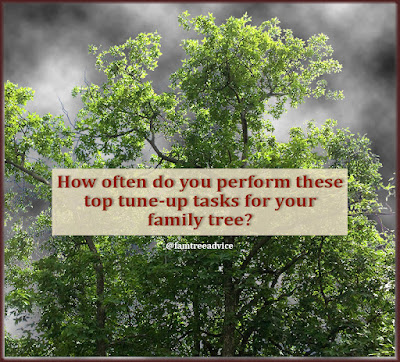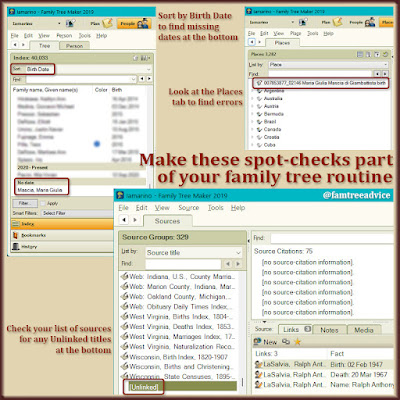We've all heard our fellow genealogy fans say it. "I wish I'd written down sources when I first started my family tree." By now I hope we're all being more thoughtful about our family research as we do it.
When I find a new document for my family tree, I follow all the steps to make sure nothing slips through the cracks:
- Crop or enhance the image if needed.
- Save it using my preferred file-naming convention (LastnameFirstnameEventYear).
- Add a title and source information to the image's file properties.
- Drag it into my family tree and add the source citation to the new facts.
- Put it in my to-be-filed folder so I can make my weekly backup copies before putting it in its proper folder.
But sometimes we can get too busy or distracted to do a perfect job. That's why we all need a checkup/tune-up list for our family tree.
 |
| Keep your family tree healthy with regular checkup/tune-up tasks. |
Top Tune-up Tasks
Here are several items to review in your tree right now to see where you were going too fast for your own good.
In your desktop software:
- DATES. Sort your index of individuals by birth date. Scroll to the bottom to see who's completely missing a year or an estimated year (see When to Use Estimates in Your Family Tree).
- PLACES. View your list of places to see if anything looks wrong. Sometimes I press Ctrl+v to paste in a town, but I paste something else that I forgot I copied.
- MEDIA. Check your media files for any uncategorized items. If you aren't using categories, they're a big help as your tree grows.
- SOURCES. See if your list of source titles has unlinked citations at the bottom of the list. This week I found a very surprising 77 unlinked citations. I have to view them one at a time to figure out what happened. In some cases I need to attach the right source to a fact. In other cases, I need to delete the empty citation.
- NAMES. The other day I found a man in my family tree named Innnocenzo with 3 Ns. If your list of people isn't too long, scan it for obvious typos.
 |
| Make it a routine to spot-check these aspects of your family tree. |
In your online tree:
- NAMES and DATES. Find the "list of all names" feature. On Ancestry.com you'll find it in the Tree Search panel. You may not be able to sort the list, but you can scan it for missing births, missing names, and typos. I found an "unknown" at the top of my list, but when I viewed the person in my desktop family tree, he had a name. It turns out I'd accidentally marked his name Private in Family Tree Maker. The only way I could have discovered this is with the online list of all names.
- GEDCOM. Export the latest GEDCOM file for your tree so you can use Family Tree Analyzer to give it a proper review. FTA has wonderful error-finding features (see How to Work Out Errors in Your Family Tree).
In your folders:
- LOOSE FILES. Everyone has their preferred way to store digital family tree files (see 3 Rules for Naming Digital Genealogy Documents). Some people store items by family name, and others use elaborate color-coding. My method is to have a folder for each major type of document, including:
- census
- certificates (vital records)
- draft cards
- immigration
- naturalization, etc.
If you're a paper person, how's that pile of documents on your desk doing?
Use Safeguards
I moved to a new computer a couple of weeks ago and made some changes. I have access to 1 Terabyte of cloud storage on Microsoft OneDrive. All the files I keep on the cloud are also on my hard drive, and they synchronize automatically.
It gives me peace of mind to know all my family tree files uploaded to the cloud all the time. That means my old computer, which I plan to take along when I travel, will always have access to the latest files.
For more safety, I copy my newest files to two external hard drives each Sunday morning (see Quick and Easy Family Tree Backup Routine). It's a ritual.
 |
| Upgrade your backup plan to protect your family tree research. |
Why go to all this trouble? Well, have you ever spent a marathon day adding new info to your family tree? Like a bunch of 1950 census pages? I have those marathon days at least 5 days a week. How would you like to lose your most productive day of genealogy research?
I hope you care enough about the tremendous work of art you're creating to give it all the attention it needs. It may sound like a pain in the neck, but when you make it a routine, it feels natural. And you'll see it's worth all the effort.
This is a GREAT list! It is similar to my own Clean Up Items but you gave me ideas I had not included before. Thank you!
ReplyDeleteWonderful! I'm glad this is helpful.
DeleteThanks for another idea-filled post.
ReplyDeleteIn regards to your statement: "How would you like to lose your most productive day of genealogy research?", that has happened to me. It was back in the days before home computers, and all the research was done in person, at grandparents' homes, at libraries, and cemeteries. My husband and I were preparing to move and all of my research as well as some precious family heirlooms (along with a 200+ cookbook collection from Junior leagues and societies) were in a storage building, allegedly safe. After we got settled into the new house and I was sure we were going to actually be there more than a few months, I went to retrieve our belongings only to find that everything was gone, not just our stuff, but the storage building, too. Twenty or so years of work, gone.
So, all the work in those notebooks and files...it all had to be done again. This time without the help of our grandparents, who had died a few years before this particular move.
Lessons learned: 1. Don't trust anyone else with things that are precious to you, and 2. If it is worth writing down one time, it is worth writing down several times and being kept in different places. If something happens to one place, you still have it somewhere else.
In today's world, that would be in the cloud, housed in the computer, in multiple external hard drives, and still print copies, too, especially of family photos.
Have a blessed weekend.
That's such a nightmare!
DeleteIt was definitely a nightmare, on many levels!
DeleteThe undead dead drive me up a wall - I don't know how many times I've looked at a match's family tree and found ancestors marked 'private' because the tree builder forgot to check 'deceased'. Estimated dates are also helpful - I know there might not be any documentation for the birth year, but as you suggest, I generally figure 25 years before the first child for men and 20 years for women. And places - I don't know where my great-great grandparents were born, only that they spoke Romanian (thank you, US 1910 census). They were probably in Transylvania, which was technically Hungary at the time, but Romanians seem to use 'Romania' for their ancestors in that region, so that's what I've done. I want to give my DNA matches all the information I've got.
ReplyDeleteI've seen one genealogist express anger over estimated birth dates — as if every record is available and we're just being lazy! But when your tree has a dozen people with exactly the same name, do you really want to accidentally attach a child to a man who's 100 years older than the baby? The estimates are important. Plus, an estimated birth year will make someone who was born 150 years ago automatically be assumed to be deceased.
DeleteI like to describe my basis for an estimated birth or death date in the description field until I can nail it down. So I have notes like "based on first child's birth" or "based on husband's birth" to keep me aware that I have fudged the date.
ReplyDeleteI have a lot of children with a death date of "Bef." the day their same-named sibling was born. Then in the description I write, "His brother [or Her sister] of the same name was born on this date." And I know that if someone's birth year begins with "Abt.", it's either the same year as their spouse, or 25 years before their eldest child.
Delete